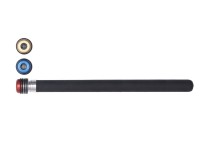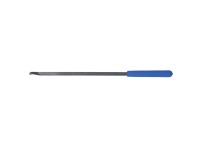
Skew Grinding
The Skew Jig was designed specifically for grinding Skews. It is quick and easy to use, and will give you an amazingly flat bevel.
BACKGROUND
One reason that the skew leaves such an incredible finish on work pieces is due to its very thin edge which leaves naturally cleaner cuts. This creates a problem with sharpening the skew as this thin edge will easily fold over during grinding. ONEWAY's Skew Grinding Attachment minimizes this problem by allowing the skew to be mechanically held. The unique offset handle position actually reduces the hollow grind generated and leaves a stronger more predictable tool.
Problem
Until now, we have been using the Wolverine Grinding Jig's Vee-Arm to grind skews. Straight from the pocket, a hollow grind can be produced at any angle you wish to achieve, or the rounded toe used by some turners. However, two problems occur using the Vee-Arm:
- the bevel of the skew should be flat, and this method does produce a hollow grind
- the cutting edge and bevel are not parallel
Solution
Solving the first problem seemed impossible, to get a flatter grind you need a bigger wheel, so we set out to solve the second problem. The result was the ONEWAY Skew Grinding attachment. Very simply the jig is two pockets offset 3-1/2" to either side of center of the wheel.
When the handle of the skew is placed in these pockets, the cutting edge becomes square to the wheel. But after we tried the jig something amazing happened. The bevel flattened itself out, which solves the first problem; excessive hollow grind.
How does this happen?
Well, as the tool is moved side to side on the wheel, the offset position of the handle forces the tool slightly up and down the wheel. As the tool is forced up the wheel it grinds more off the back of the bevel and flattens the grind. The Skew Grinding Attachment produces a virtually flat bevel with greatly improved cutting characteristics. This fixture is a highly recommended option with our Wolverine Grinding System.
SKEW SHAPE:
The skew, in order to cut effectively, should be ground with an angle of 70 degrees to 80 degrees looking from the top, and an included angle of 20 degrees to 35 degrees, depending on the wood to be cut and personal preference. The surfaces should be flat, not convex or concave. In an attempt to obtain a flat surface, some turners will grind the skew on the side of the grinding wheel, but this method is not recommended as some roundness will occur and for safety reasons.








































